Motor Skin
In the early part of the twentieth century the Pompeian Manufacturing Company advised automobilists to use Pompeian Massage Cream to overcome the problems of ‘automobile complexion’, also known as ‘motor skin’.
The vogue of the machine has meant the vogue of bad complexions. Not alone are wind and sun enemies to good, clear, soft skin. Dust is an enemy, and often the chief one. Dust gests into the pores and can’t be dislodged by ordinary cleansers. A complete cleanser like Pompeian Massage Cream is absolutely necessary for good skin health of automobilists.
You gather the dust of the machine ahead. Your face is continually receiving dust kicked up by your own car. This may be often insensibly gathered over the back by means of the vacuum created by your own speed, however slight it may be. This dust gets into the pores to an astonishing degree and works havoc with the skin.(Pompeian advertisement, 1909)
Early automobiles
As the name ‘horseless carriage’ indicates, early motor cars came without windows, doors or tops, so occupants were exposed to all the extremes of the weather. The wealthy, who were the only ones who could afford early motorcars, tried to ameliorate the conditions by having their tailors and milliners develop motoring outfits to protect them from the wind, rain, heat, cold and dust.
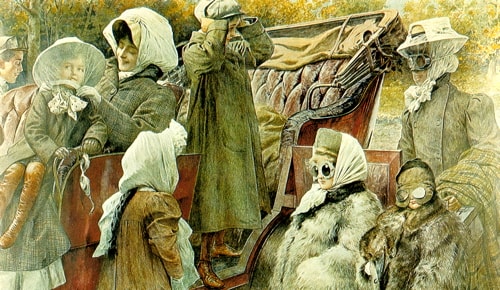
Above: Getting ready for a family motoring excursion.
Women used a wide variety of veils, hoods and goggles to protect their faces and keep their hats on.
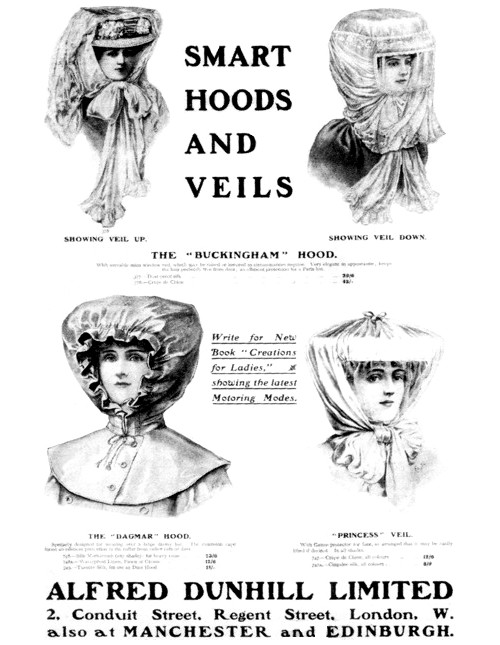
Above: An assortment of early motoring head-wear made for women by Alfred Dunhill Limited.
Most travel in the steam age and in coal burning cities was dirtier than it is today. However, despite being exposed to the elements, early city driving was probably not too bad as automobiles were slow, trips were generally short, city roads were often paved, and streets were cleaned by street sweepers. Cars did kick up some dust – containing general detritus, coal dust and dried horse manure – but it was probably more irksome for those that followed, or for passers by, than for anyone in the motor itself.
Country driving
As automobiles became more powerful – reaching speeds of 80 kmph (50 mph) or so – they were increasingly taken for long drives into the country where the elements, particularly wind and dust, became more of a problem. In summer, roads made of compacted earth or stone threw up large amounts of dust and this collected on the skin, hair and clothes.
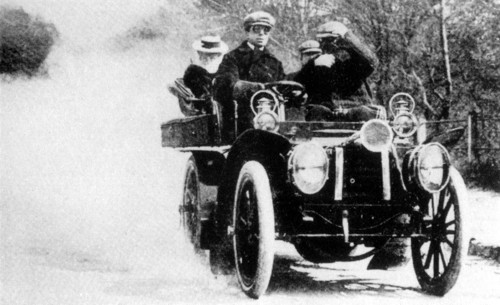
Above: Motoring dust. Note the woman with her head covered in a veil. Unless you have travelled on a dirt or gravel road in the middle of summer it is hard to imagine just how much dust and grime was associated with the early days of the automobile.
Travelling for long distances in the outdoors also increased exposure to the effects of wind and sun. Wearing cumbersome protective clothing in summer was uncomfortable, so women looked to cosmetics to protect their skin from the worst of the conditions. Beauty columnists were soon offering their readers advice on this subject and continued to do so for many years.
Any girl who cares anything about her beauty will motor in a cream mask, that is, with a coating of cream to protect her skin. And the leather skin for those who don’t.
(The Sun, 1904)
Automobiling in the early spring is undoubtedly injurious to the complexion, for the breezes are not soft and the dust is irritating to the skin. It would be a pity, however, for the girl who cares for her complexion to altogether eschew the sport, and there are many things she can do to render the trip harmless.
Naturally, when one goes for an afternoon spin in a motor, the wind and the dust would not be enough to cause any bad effect whatever on the complexion, but so many people nowadays take such long trips, regardless of wind and weather, and the treatments suggested are for these; for no girl wants to acquire a typical “motor skin”—a harsh, coarse complexion that soon takes all the youth from her face.
Before starting on the trip some good cold cream should be massaged well into the skin with a rotary action, always working upward and outward from the corners of the mouth. This keeps the wind from drying too much the complexion and from biting into the skin.
… The massaging has given the complexion a tonic—a help to withstand the incessant breeze made by the swift motion—but the last act, before tying on the veil, should be to powder the face, giving it as far as is possible an extra coating. Next the veil and the girl is ready to face anything.
But the care of her complexion is not yet complete, for, when she comes home, the dust has made the face smart—it is unused to such strong breezes—and she must dampen cloths in whisky and lay them on her face. While the whisky is healing the skin she should lie down, relaxing so the muscles and tiny tendons will have complete rest, thus avoiding wrinkles and crows feet.(The Washington Herald, 1908)
[T]he motor is doing its best to promote all sorts of skin trouble, and women who motor constantly are regularly in the hands of complexion specialists. Say what we will about the delights of motoring, it works havoc with the complexion.
When one took one’s exercise in a carriage and on horseback a gentle breeze played on the skin and refreshed it; but now when one goes tearing along at an unknown reckless rate of speed, creating a fierce wind as one flies, which meets a violet wind and battles with it, it is not surprising that the skin suffers. Add to this the dust sometimes laden with germs and always with fine particles of grit and pebbles and one has a condition that naturally is not beneficial to the skin.
Fashionable women are everywhere flocking to physicians and begging for a remedy against this motor skin. … A paste has been concocted, which is spread upon the face, and remains there until the motor journey is finished. It has all the appearance of a powder after it is applied to the skin, and does not detract from one’s appearance.
But ointments of this sort are expensive luxuries, beyond the reach of the girl who only occasionally has the happiness of a motor trip, but a good cold cream in inexpensive and a protection to the complexion, if one is in a motor for any length of time.
It should be spread over the entire face and portion of the neck exposed and then thoroughly dusted with rice powder. The powder should be put on thick, since it has to withstand a fierce wind. When the motor trip is over, the face should be thoroughly cleansed with witch hazel or glycerine and rose water and lemon juice or else merely in the lemon juice alone.(New York Times, 1911)
Motoring in open cars is particularly hard on dry, sensitive complexions and when such trips are to be taken, one must be sure to use an oily powder base and a face powder that clings. The oil treatment will be found soothing after such exposure.
(Brooklyn Daily Eagle, 1931)
Motoring season
The democratisation of the automobile, that began with the development of the Model T Ford in 1908, put a lot more machines on the road. Drivers of these cheaper vehicles encountered all the problems of their wealthier predecessors with the added disadvantage that there were now more vehicles to kick up dirt and dust. Until the roads were sealed with tarmacadam (tarmac), concrete, asphalt or something similar, the wind and dust would have taken some of the gloss out of driving in the annual motoring season.
In the motoring season, women are apt to suffer a good deal of discomfort through high winds and dust-clouds “whipping” against the face, cracking the lips, and rendering the skin harsh … Prevention is better than cure in every case, and before going out in an open motor, a little camphor ice should be rubbed into the lips, while the complexion should have the protection of a coating of cold cream, almond milk or something of the kind, well rubbed into the skin, and supplemented by a dusting of ground oatmeal.
(Wanganui Chronicle, 1917)
Portable skin creams would have been useful here. Many cold and vanishing creams came in purse-sized tubes that enabled women to freshen up after a road trip and then reapply skin creams before returning home. Pompeian specifically acknowledged this when it referred to the tube form of its products as ‘motorist tubes’.
Attitudes to automobiles
The attitude of cosmetic companies to early automobiles were mixed. Although not common, perfumes and make-up were occasionally associated with the wealth, glamour and independence that the automobile represented – women were drivers as well as passengers – but motoring was more often seen as a source of skin problems that needed treatment and the purchase of skin creams.
[A] good many complexions are being injured by motoring. Suppose you go out in a car which runs at a speed of twenty-five miles an hour, which is common for country driving. And suppose you are running against a moderate wind of twenty-five miles an hour. That means that you have to meet a winds of fifty miles an hour—which is not moderate. The wind alone will make your skin dry and harsh. Add to that the dust and sand that is driven into your pores. Add also the effect of sunlight, if you are in an open car. No complexion can stand that ordeal without suffering. Yet women constantly motor under these conditions; and most of them do not know that, before starting, they can and should put on a preparation which will protect the skin against both wind and sun.
(Helena Rubinstein, 1922)
Some cosmetic companies were more positive. Primrose House put together a complete kit to enable a woman to enjoy the pleasures of motoring without any ill effects.
Primrose House Motor Kit: To take care of the woman who wants to enjoy motoring to the fullest without any had after effects on hands and complexion, we have planned the Motor Kit. Here is a handy little box, fitted out with just those beauty aids which the motorist needs: Rose Leaf Cleansing Cream, Cleansing Tissues, Smooth Skin Cream, Skin Freshener, Pomegranate Rouge, and Chiffon Powder. The box is so smart in its black and vermilion cover that it delights the eye as well as the heart.
(Primrose House advertisement, 1922)
Saloon cars
Like Pompeian Massage Cream, ‘motor skin’ or ‘automobile complexion’ was not here to stay. As automobile design developed, greater protection against the elements was afforded to the occupants of the car, decreasing the need for skin protection. By 1927, over 80 per cent of the cars produced in America were enclosed by windows, doors and a roof, as compared to 10 per cent in 1919 (Allen, 2000, p. 86). This meant that motorists no longer needed to be a Spartan or to dress up in outlandish clothing to go for a drive.
As ‘motor skin’ or ‘automobile complexion’ ceased to be a problem, cosmetic companies raised other issues associated with the outdoor life – a lifestyle the automobile helped to establish. Swimming, sailing, playing golf or simply walking in the countryside were all described as having an effect on the skin, requiring treatments and the use of specialist skin preparations.
Manners and morals
As well as providing greater protection from the weather, closed automobiles gave the younger generation a room on wheels that could be moved away from the prying eyes of parents, chaperones and neighbours. One could simply step into a motor and drive off. When combined with other developments of the 1920s, such as sex and confession magazines, lurid motion pictures, Marie Stopes family planning methods and the hip flask, the automobile delivered a sense of freedom generally unavailable before the war and this contributed to the revolution in manners and morals that took place during that decade. Outward signs that things were changing were womens’ dress and appearance, notably the arrival of shorter and skimpier clothing, the bob, the cloche hat, and the frank use of ‘paint’ applied in public.
First Posted: 5th September 2011
Last Update: 17th April 2023
Sources
Allen, F. L. (2000). Only Yesterday: An informal history of the 1920’s. New York: Harper & Row.
Lane, A. (1987). Motoring costume. Aylesbury, Bucks: Shire Publications.
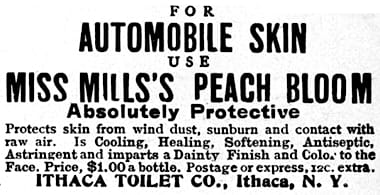
1905 Miss Mills’s Peach Bloom.
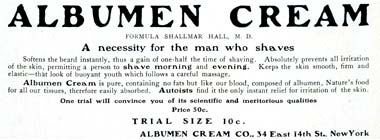
1906 Albumen Cream. “A necessity for the man who shaves… Autoists find it the only instant relief for irritation of the skin”.
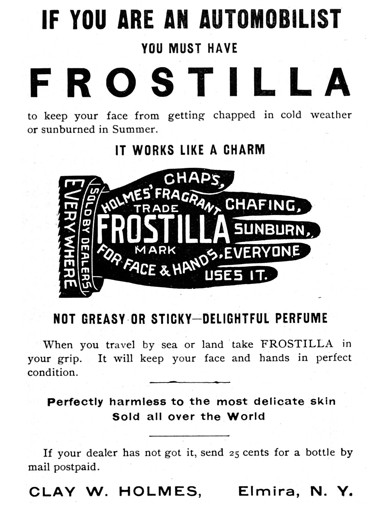
1906 Frostilla.
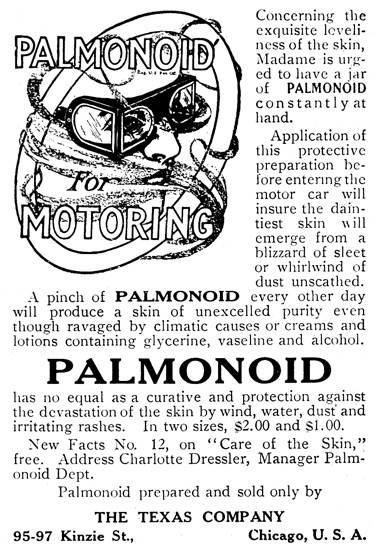
1908 Palmonoid for Motoring.
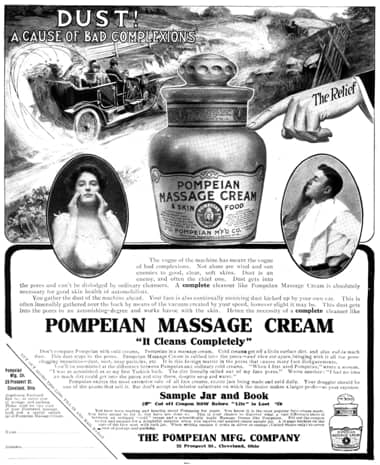
1909 Pompeian Massage Cream. Dust! A cause of bad complexions.
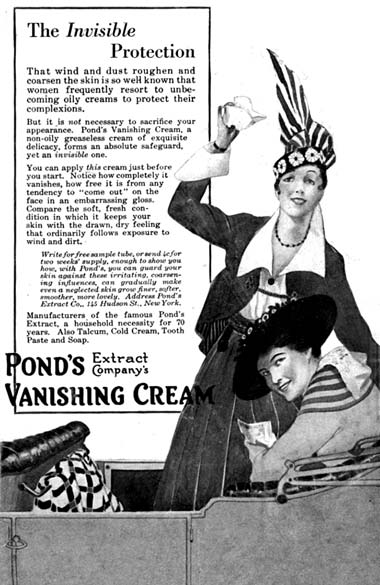
1915 Pond’s Vanishing Cream “invisible protection”.
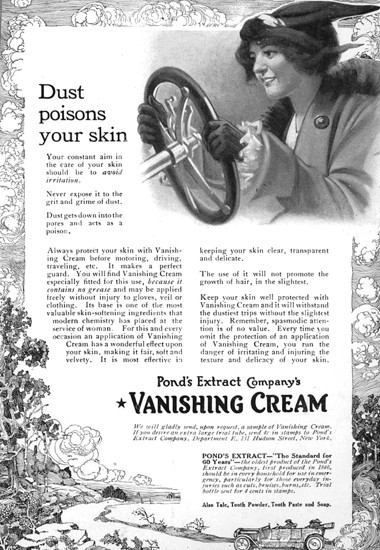
1915 Pond’s Vanishing Cream dust protection when motoring.

1919 Marinello Motor Cream.
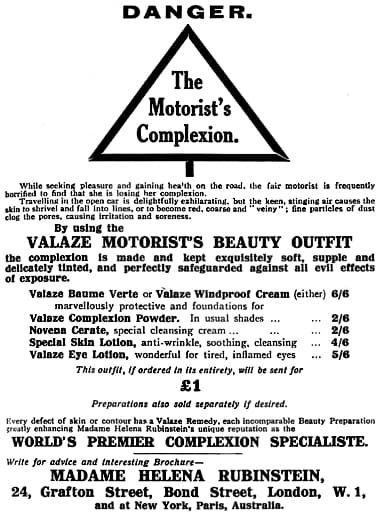
1919 Helena Rubinstein. The Motorist’s Complexion.
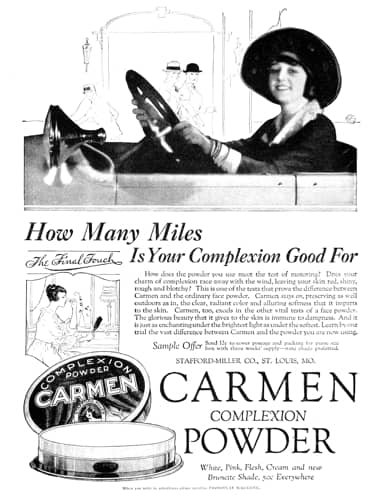
1921 Carmen Complexion Powder protects against the “tests of motoring”.
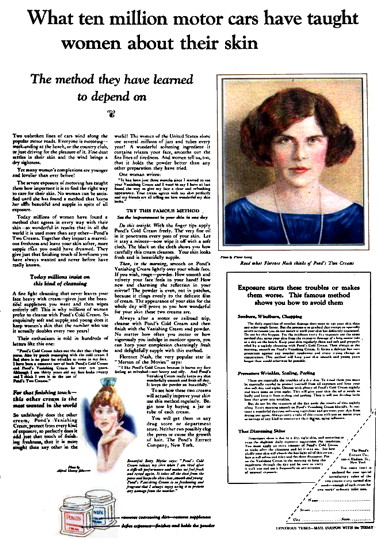
1923 The motoring uses of Pond’s Cold and Vanishing Cream.
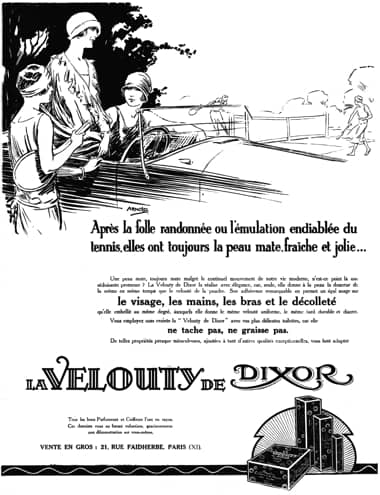
1925 Velouty de Dixor. Outdoor activities like tennis and driving require good skin care.
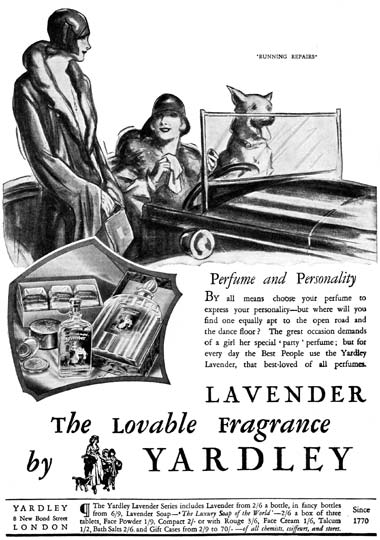
1930 Yardley advertisment using the glamour and freedom associated with automobiles to promote their fragrance.

1935 Pond’s combines a skin protection message with the sense of freedom and social status that driving engenders.
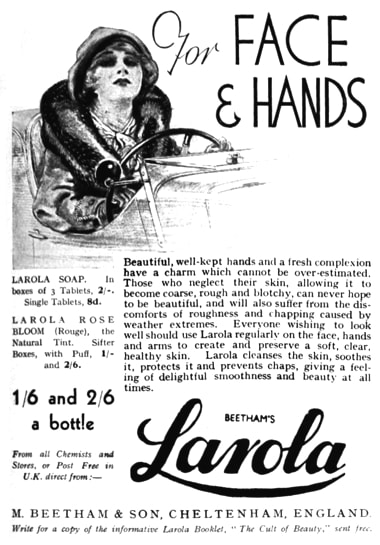
1936 Beetham’s Larola Cream.
